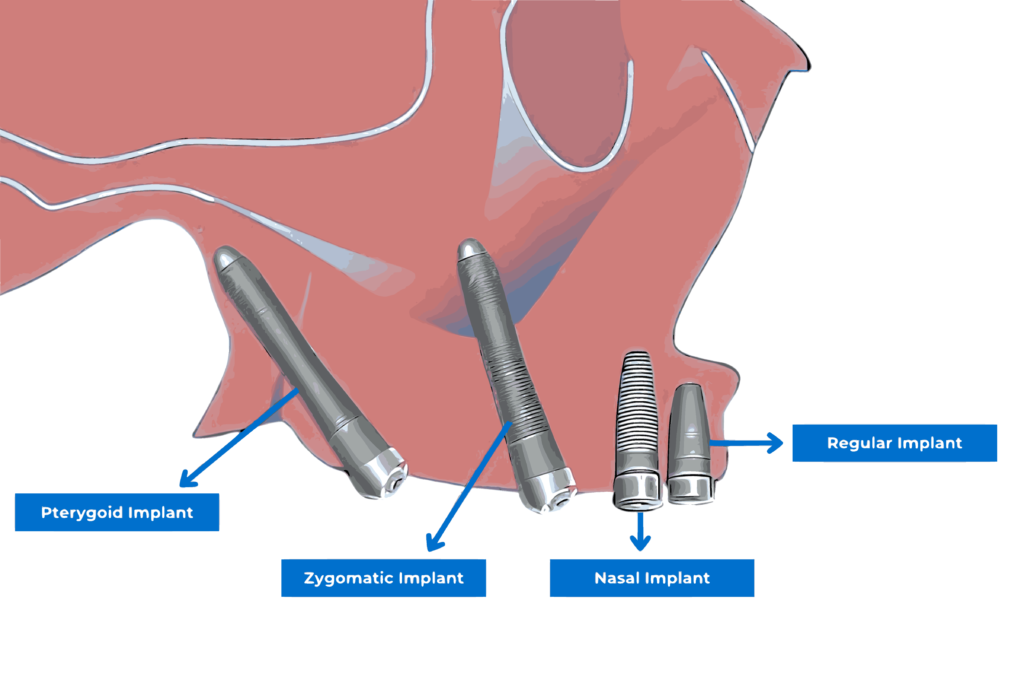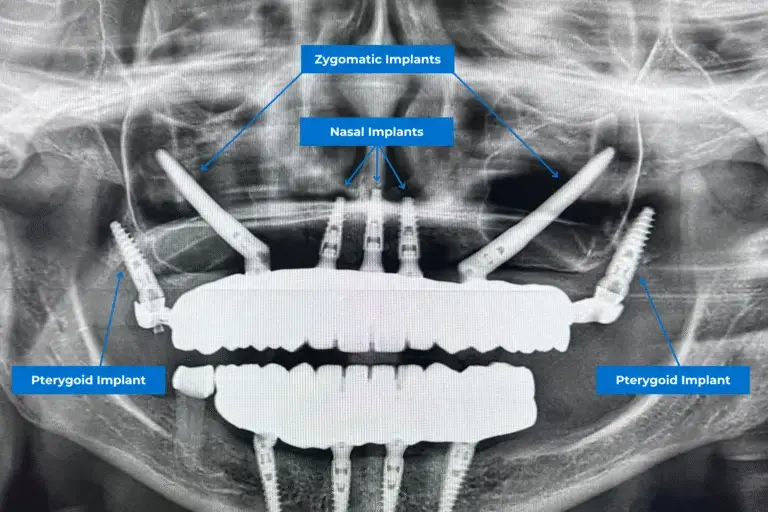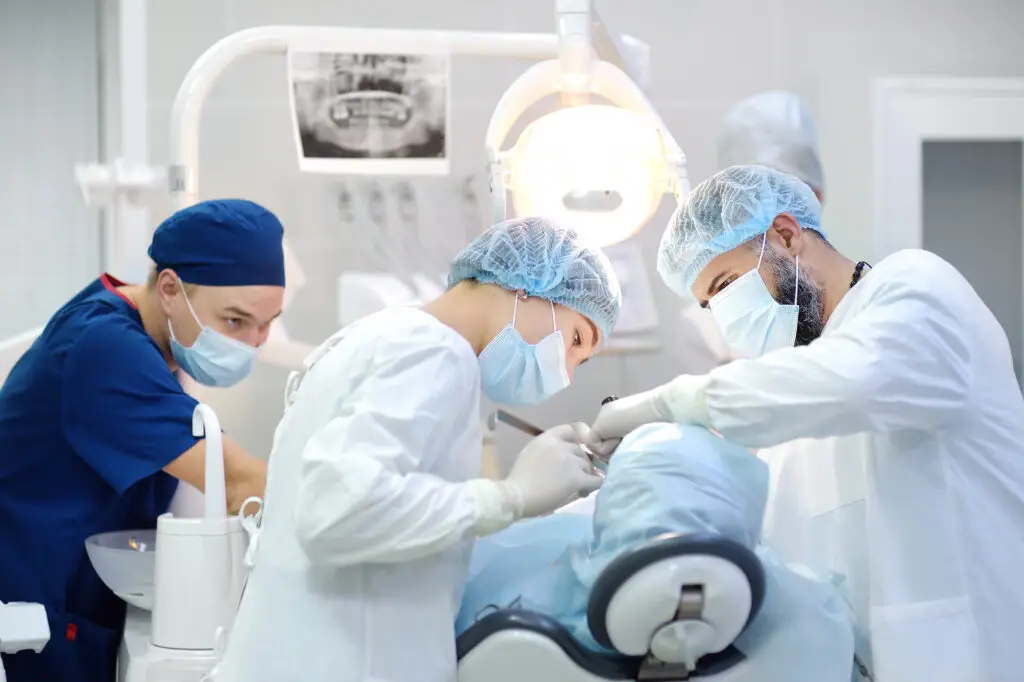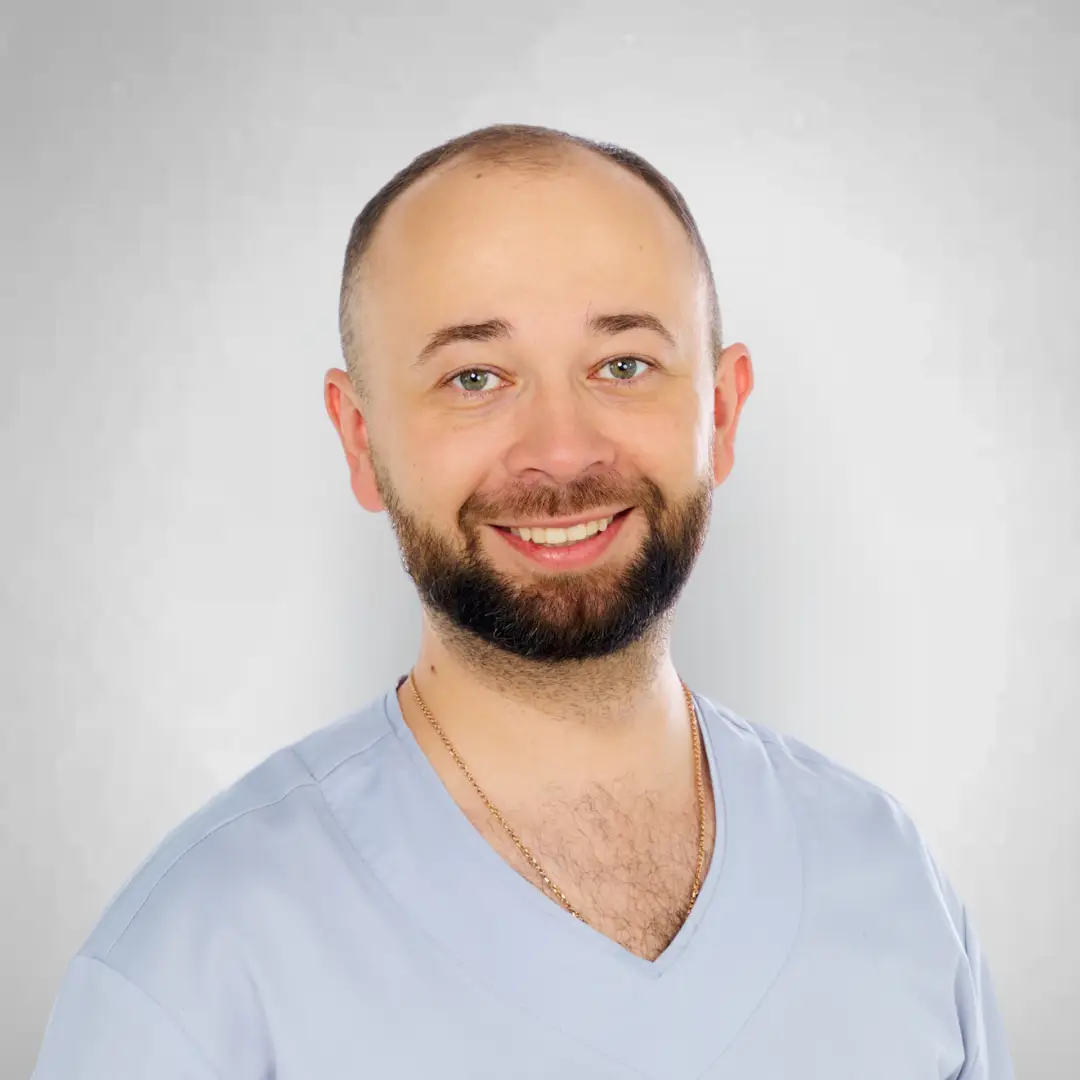What Are Nasal Implants?
If you’ve been told you don’t have enough bone for traditional dental implants, advanced alternatives such as zygomatic, subperiosteal, and pterygoid implants may still make treatment possible. Another effective solution is nasal (transnasal) dental implants, designed for patients with severe upper jaw bone loss and complex maxillary atrophy.
Discover what nasal implants are and why they are gaining recognition in full-mouth restoration, guided by Dr. Taras Yurov, certified ZAGA Doctor at ZAGA Center Saint Petersburg, and expert in treating the most challenging implant cases.
Table of Contents
What Are Nasal or Transnasal Implants?
Nasal Implants, or transnasal implants, are extra-long dental implants placed through the upper jaw and nasal cavity to anchor into the dense bone of the frontal process of the maxilla. Designed to provide stability in areas where bone loss is extensive, these implants are ideal for patients who have been told they’re not candidates for conventional implants due to insufficient bone density.
By utilizing the robust structure of the nasal bone, nasal dental implants create a strong and lasting foundation for fixed dental prosthetics, restoring both function and aesthetics to patients with complex cases, keeping an exceptionally high success rate.

Why Would Your Doctor Choose Transnasal Dental Implants?
For decades, patients with severe upper jaw bone loss have faced limited options, often requiring invasive bone grafting procedures. However, transnasal implants offer significant advantages:
- Avoid Bone Grafts: No need for extensive grafting procedures, reducing surgical time and recovery.
- Support in Complex Cases: Transnasal implants expand the available treatment options for patients with challenging anatomies, allowing the combination of different types of implants.
- Immediate Results: In many cases, patients can receive a fixed prosthesis on the same day of surgery, restoring function and appearance instantly.
- Cost-Effective: By eliminating the need for additional grafting and reducing surgery time, these implants offer a more affordable solution for full-arch rehabilitation.
- Minimally Invasive: Patients benefit from a less invasive approach with quicker healing times and reduced discomfort.
How Do Transnasal Implants Work?
Transnasal Implants are inserted through the mouth and into the nasal cavity. The procedure begins with advanced digital planning using 3D imaging (CBCT scans) to ensure precise implant placement. The implants pass tangentially through the lateral wall of the nasal cavity and anchor deeply into the frontal process of the maxilla, a dense bone area ideal for long-term stability.
These implants are typically combined with zygomatic or conventional implants in a hybrid full-arch solution, especially in All-on-4-style treatments, to maximize support in cases of extreme bone atrophy.
Who Can Benefit from Nasal Implants?
You may be a candidate for transnasal dental implants if you:
- Suffer from severe upper jaw bone loss.
- Have been told you’re not suitable for traditional implants.
- Want to avoid bone grafting procedures.
- Seek a fixed, long-lasting solution to replace dentures.
- Are looking for a quicker recovery and immediate functionality.
However, not all patients are eligible. The nasal anatomy must provide enough space between key structures like the nasolacrimal duct, and the bone in the frontal maxillary area must be dense enough for secure implant anchorage. A detailed examination by a specialist is essential to determine your suitability.
Global Reach, Local Expertise: ZAGA Centers in Saint Petersburg
At Smile24h, we work exclusively with ZAGA Certified Doctors who follow precise, patient-first protocols for guided implant surgery. Patients in Russia can rely on the expertise of the Dr. Taras Yurov,– ZAGA Center Saint Petersburg, part of the trusted Smile24h Expert Clinic in Saint Petersburg, where advanced digital planning and guided techniques ensure predictable, high-quality implant results aligned with global ZAGA standards.
Nasal Implants as Part of a Comprehensive Approach
While zygomatic implants anchor into the cheekbone and pterygoid implants into the pterygoid process, nasal dental implants complement these techniques by providing additional support through the nasal bone, particularly in the anterior region of the upper jaw. In some cases, all three types may be combined to create a stable foundation for patients with extreme bone loss.

Transnasal Implants are especially valuable when:
- The anatomical conditions are suitable for additional anterior anchorage.
- There’s a need to enhance support in combination with zygomatic implants.
- You want to achieve immediate function with a tailored, multi-implant strategy.
Patient Success Stories
Many patients who once thought they had no options due to severe bone loss have experienced life-changing results with comprehensive treatments that include Transnasal Implants. With the combined use of advanced techniques like zygomatic, pterygoid, and nasal implants, full-arch rehabilitations have become more predictable and accessible than ever before. Patients frequently report not only restored oral function but also renewed confidence and improved quality of life.
Why Choose a Specialist in Nasal Implants?
Due to the complexity of transnasal implants, it is crucial to trust your care to an experienced implantologist. The planning and placement of these implants require deep anatomical knowledge and advanced surgical skills. A specialist will ensure precise digital planning, safe execution, and optimal long-term outcomes.
Combining innovative technology with proven expertise, specialists can design a custom treatment plan tailored to your unique needs, maximizing both function and aesthetics.
Conclusion
If you are considering dental implants but have been told you lack sufficient bone, nasal implants could be an essential part of a comprehensive treatment plan. By utilizing the strength of the nasal cavity alongside other advanced techniques like zygomatic implants, Transnasal Implants offer a safe, predictable, and lasting solution for full-arch rehabilitation.
The success and long-term stability of the outcomes depend largely on the expertise of the professional who performed the treatment. That’s why, at Smile24h, we always recommend choosing one of our Smile24h Expert Clinics, also known as Certified ZAGA Centers, as you ensure a customized treatment plan with a “patient-first” approach. Certified ZAGA Centers and their professional teams of experts will provide a warmly familiar environment and meet all your needs and expectations.

“In some cases, all three types (of dental implants) may be combined to create a stable foundation for patients with extreme bone loss."

Dr. Taras Yurov is a leading oral and maxillofacial surgeon and implantologist based in Saint Petersburg, where he heads the Department of Oral and Maxillofacial Surgery at the Digital Dental Center MEDALL. He is highly regarded for his expertise in complex osteoplastic surgeries and the advanced ALL-ON-4 rehabilitation protocol, including zygomatic, pterygoid, and transnasal implants. His practice also covers implantology and aesthetic dentistry, providing comprehensive and innovative care.
A graduate of St. Petersburg State Medical University, Dr. Yurov completed his residency in 2013 and continually updates his skills through international congresses and advanced training abroad. As a clinical expert for Nobel Biocare, he shares his knowledge with peers worldwide, particularly in zygomatic implantology and the ALL-ON-4 method. His commitment to excellence ensures every patient receives a personalized treatment plan focused on restoring both function and confidence.
Still have questions? Find your nearest specialist and discover how we can help improve your quality of life with expert care
Frequently Asked Questions (FAQs)
Nasal dental implants, also known as transnasal implants, are advanced implants placed through the nasal floor to anchor into stable bone. They are designed for patients with severe upper jaw bone loss who cannot receive traditional dental implants.
Nasal implants are suitable for patients with advanced maxillary atrophy, severe bone loss, or those who have been told conventional implants or bone grafting are not possible.
While both are used for severe bone loss, zygomatic implants anchor into the cheekbone, whereas nasal implants engage the bone around the nasal cavity, offering an alternative when other implant techniques are not feasible.
Yes. When performed by experienced specialists, such as Certified ZAGA Doctors, nasal implants are a safe and predictable solution for complex upper jaw restorations, providing stable, long-term support for fixed teeth.
